Soldier Story: Richard S. Furukawa
Soldier Story
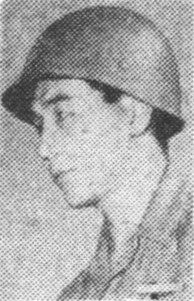
Richard Shizue Furukawa
Technical Sergeant
442nd Regimental Combat Team
3rd Battalion, L Company
Richard Shizuo Furukawa was born on January 31, 1922, in Wahiawa, Oahu, Territory of Hawaii, to Henry Roichi and Kiyome (Kanemaru) Furukawa. He had two younger sisters, Adaline Kikuyo and Gertrude Kazuko, and a younger half-brother, Hubert Takashi.
Father Henry Roichi was born in 1898 in the Waimalu neighborhood of Honolulu. His parents, Sekitaro and Tsui (Obatake) Furukawa, had emigrated from the village of Nihojima, Aki District, Hiroshima Prefecture on the Miike Maru, arriving on June 19, 1893. They came in the 24th batch of contract immigrants and were assigned to the Hawaiian Sugar Company at Makaweli, Kauai.
Mother Kiyome Kanemaru was born in 1903 in Heeia, on the windward coast of Oahu. Her parents were Iwajiro and Kyo (Kimura) Kanemaru, who emigrated in 1895 and 1897, respectively, from the village of Kaita, Aki District, Hiroshima Prefecture. Iwajiro was a retail merchant and Kyo was a cook at a Japanese boarding house.
Richard’s parents married in 1920. In 1930 the family was living in Wahiawa. Father Henry was employed as a sales manager of automobile accessories and mother Kiyome was a dressmaker operating from home. In 1934, the couple divorced. In 1937, Henry married Beatrice Hanako and they had one son, Hubert Takashi.
By 1940, Kiyome had married Makoto Tasaki and the family lived at 725 California Avenue in Wahiawa. Makoto was the proprietor of a restaurant and Kiyome was a dressmaker in her own shop. While in high school, Richard was Vice President of the Wahiawa Youth Association and on their basketball and volleyball teams. He also belonged to Leilehua High School’s Hi-Y club and was a camp counselor in 1940 at the YMCA’s Camp Erdman on Oahu’s North Shore.
Furukawa graduated from Leilehua High School in 1941. He then attended the University of Hawaii for about one year.
Richard signed his draft card on June 30, 1942, Local Board No. 10, Wahiawa. His point of contact was Doctor Kanemura and he lived with his family at 725 California Avenue. He was employed by Hawaiian Constructors at Wheeler Airfield near Wahiawa. He was 5’7½” tall and weighed 150 pounds.
On March 23, 1943, Furukawa enlisted in the U.S. Army. He had completed high school and his occupation was “Semi-skilled garage laborer/car washer and greaser.” He was sent to the “tent city, “nicknamed Boom Town, at Schofield Barracks with the other new soldiers.
The 442nd volunteers sailed on April 4 on the S.S. Lurline for Oakland, California, where they were sent on a train trip across the US. They arrived at Camp Shelby, Mississippi, where they were assigned to their units. Private Furukawa was assigned to 3rd Battalion, L Company, 1st Platoon.
While at Camp Shelby, in March 1944, Furukawa began to work on two photo albums that he made during the war.
Below: Covers of both albums and photos of friends at Camp Shelby, 1943. Top row L to R: Shigeo “China” Warashina (Service Battery, 522nd Field Artillery Battalion); Saiji Zakimi (L Co.), Yoshimura, Yamada; Hiroshi Watanabe (L Co., killed in action); Deems Shigeo Tsukamoto, Yoshimura; Robert M. Yukitomo; Deems Shigeo Tsukamoto.
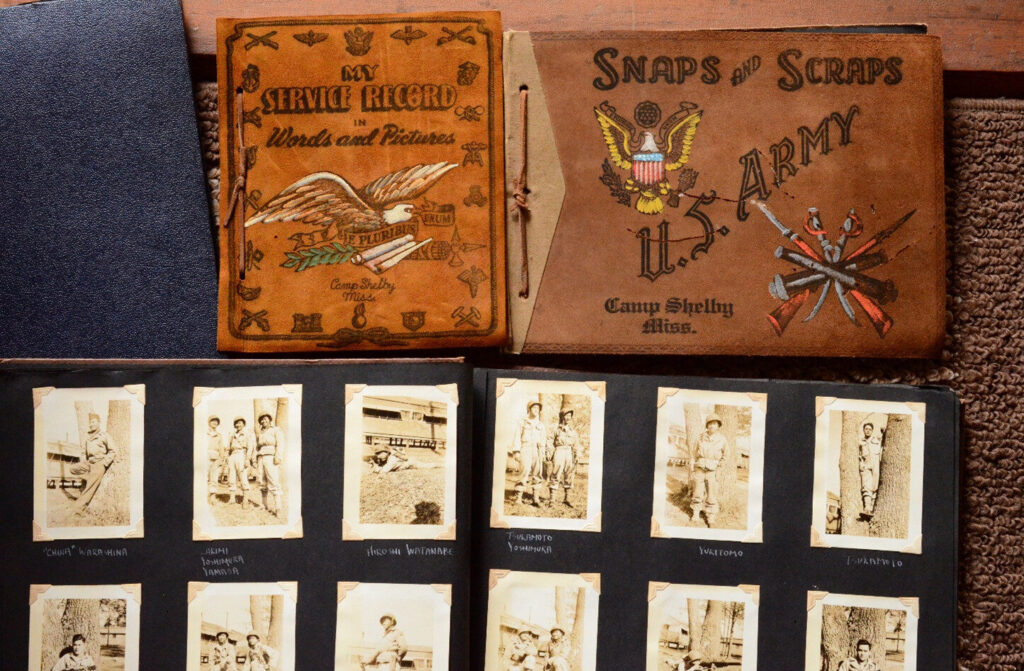
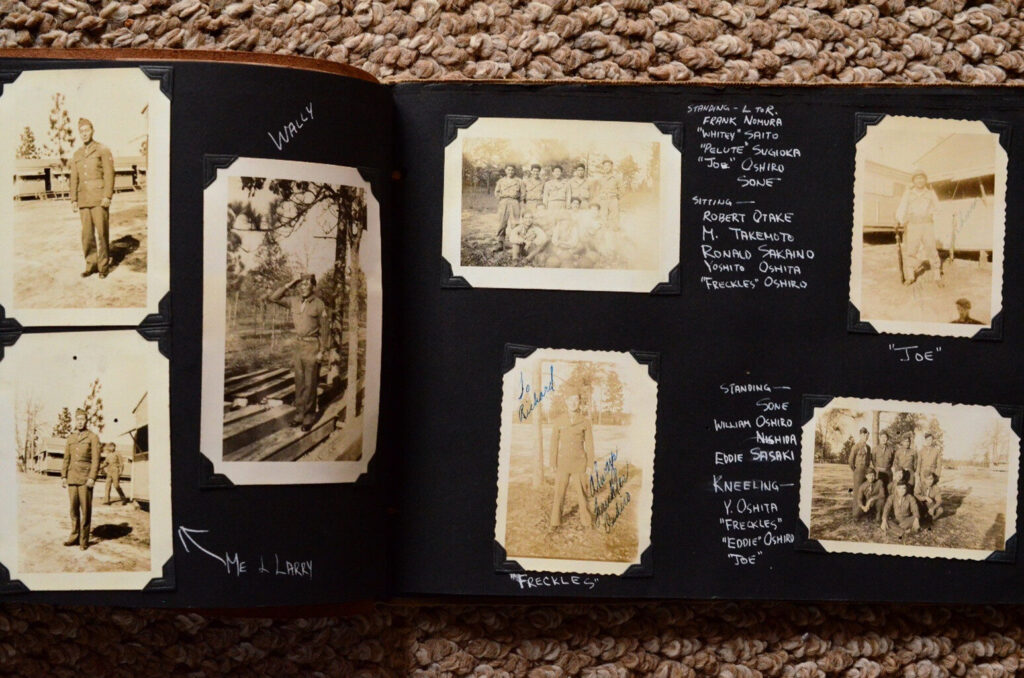
Above: Taken during training; Richard is in the upper and lower photos at the far left. “Wally” is shown saluting. Top row left: L Co. men – Frank Nomura, “Whitey” Saito, “Pelute” Sugioka, “Joe” Oshiro, Shigeru Sone. Top row right: “Joe.” Bottom row left: “Freckles” Oshiro. Bottom row right: Standing – Shigeru Sone, William Oshiro, Richard K. Nishida, Eddie Sasaki; Kneeling – Yoshito Oshita, “Freckles” Oshiro; “Eddie” Oshiro, “Joe.”
After a year of basic and specialized training and field maneuvers, the 442nd left by train for Camp Patrick Henry, Virginia, on April 22, 1944. On May 2, they left from nearby Hampton Roads in a convoy of about 100 ships, and arrived at Naples, Italy, on May 28. L Company was aboard the S.S. George W. Campbell.
The Combat Team spent a week at a staging area in nearby Bagnoli before leaving on LSTs for the recently freed Anzio beachhead on June 6, where they marched five miles to a bivouac area. From Anzio, the 442nd went by truck convoy around Rome to a larger bivouac area at Civitavecchia, where they went through additional training and final preparations for going to the front lines. The 442nd entered combat in the Rome-Arno Campaign on June 26, 1944, near Suvereto, about 107 miles north of Civitavecchia. Thus began the series of fierce battles to push the enemy north along the west coast of Italy, with the mission of liberating Pisa.
After successfully pushing to the Arno River, on September 6, 1944, the 442nd was detached from the 88th Division and moved south, prior to being transported to Naples and shipment later in the month to its next assignment – the Rhineland-Vosges Campaign in France.
In France, during October and November, 1944, the 442nd engaged in their most bitter fighting yet. They were transported 500 miles north from their arrival in Marseilles to the Vosges Mountains of northeast France, close to the German border. After liberating the important rail and road town of Bruyères and the nearby villages of Belmont and Biffontaine, they were given a brief rest in Belmont before suddenly being ordered back to the front lines. Their mission was to rescue the 1st Battalion of the 141st (“Texas”) Regiment that had become nearly encircled behind enemy lines. Attempts by other units of the 141st had failed in the rescue. On October 30, the Texans were rescued. Furukawa later described the Rescue of the Lost Battalion as “a constant firefight with a well-trained and well-supported enemy.”
After the famous rescue, L Company was ordered to continue on and clear the mountain ridge near the village of La Houssière. They encountered intense enemy resistance in the thick forests of the Vosges. They dug in at the top of the ridge about 30 yards from the enemy. In front of them were strung barbed-wire lines and a German minefield. They lost four men in trying to disarm a mine. After their 1st Platoon leader, Lt. Koizumi, was wounded as he went back to the L Company command post for instructions, Furukawa and Platoon Sergeant Genro Kashiwa discussed their dire situation and decided on a frontal assault. The two men crawled through the minefield, cutting wires and creating lanes for their men to advance. They miraculously were not shot. He was to receive a Silver Star for this action. Years later, Furukawa reluctantly told Kashiwa that this incident had haunted him for 50 years.
After the ridge was cleared, in Furukawa’s 1st Platoon, there were no officers and only 13 enlisted men left, Tech Sergeant Genro Kashiwa was in charge, and Furukawa was one of four men remaining of the original 12 in his 1st Squad.
Finally, on November 17, the 442nd was relieved from the front lines after 25 days of heavy fighting. At the time, they were under-strength due to high casualties. As a result, the Combat Team was sent to southern France to rebuild to full combat strength while fighting in the Rhineland-Maritime Alps Campaign. This was mostly a defensive position guarding the French-Italian border from attack by the German Army in Italy.
On arrival in the south, Furukawa and the 3rd Battalion relieved the 19th Armored Infantry Battalion in the small border town of Sospel on November 23. From there, the men headed for the higher mountains. Where there were passible roads to the border forts on the peaks, they rode in trucks. Otherwise, they climbed the 4,000-foot peaks with pack mules and equipment. Combat and reconnaissance patrols roamed back and forth between the lines, sometimes making enemy contact. There were a lot of mines in the area and no knowledge of where they were. Thus, many 442nd men were wounded by U.S. mines. Often, the Germans fired artillery at the 442nd as a reminder of their presence.
On December 21, 3rd Battalion was in the area of Sospel and was relieved by 2nd Battalion. They moved to the nearby village of L’Escarène as regimental reserve. The 3rd Battalion companies got together and hosted a Christmas party for the children of the village. During the rest of the 442nd’s time in southern France, the pattern of alternating duty in the Sospel area continued. The men were often given one-day passes to enjoy leisure time in Nice. For this reason, the Rhineland-Maritime Alps was nicknamed the “Champagne Campaign.”
Below: From Furukawa’s well-annotated photo album during the Maritime Alps Campaign at Col de Braus, photos taken January-February 1945. Top row L to R – Thomas (“Tommy”) Takeishi Kiyama; “Kewpee” Miyamoto; Furu (Richard S. Furukawa); Takao (“Killer”) Haraguchi.
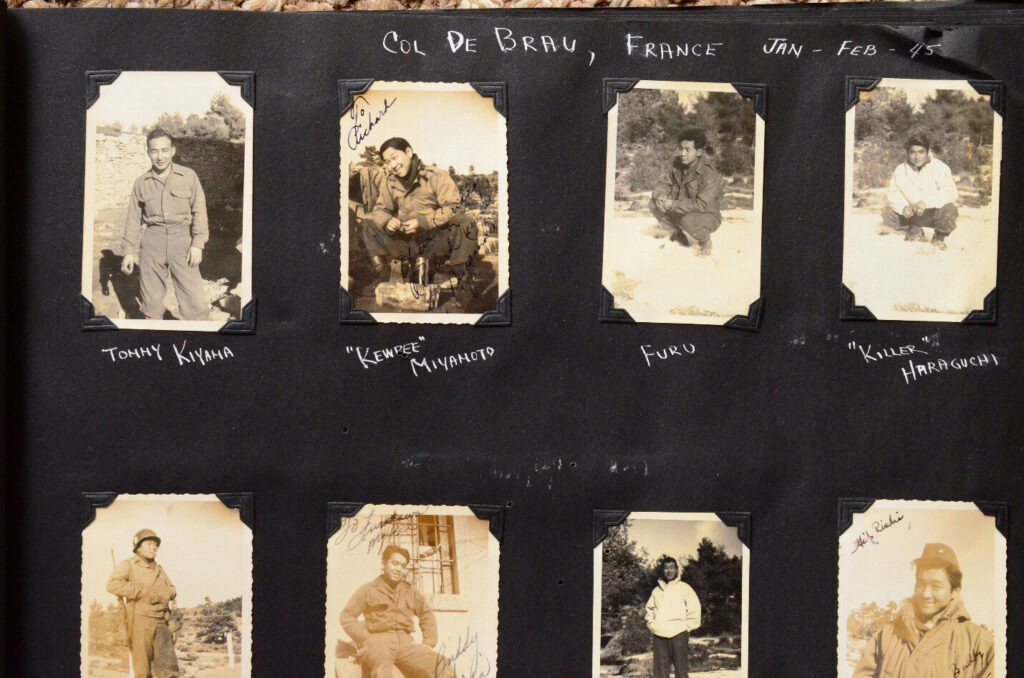
The 442nd was in southern France from November 23, 1944, until March 15, 1945, when they were relieved and moved in relays to a new staging area at Marseilles. On March 20-22, the 442nd (without its 522nd Field Artillery Battalion who were sent to Germany) left France to fight in the Po Valley Campaign for the final push to defeat the Nazis in Italy. They arrived at the Peninsular Base Section in Pisa on March 25 and were assigned to Fifth Army.
The objective of the 442nd was to execute a surprise diversionary attack on the western anchor of the German Gothic Line. This elaborate system of fortifications had been attacked repeatedly in the fall of 1944, but no one had yet been able to pry the Germans loose from the western end. The Gothic Line in this area was hewn out of solid rock, reinforced with concrete, and constructed to give all-around protection and observation. The Germans were dug into mountain peaks rising almost sheer from the coastal plain, bare of vegetation save for scanty scrub growth.
The Combat Team left their initial staging area in Pisa and moved to a bivouac at San Martino, just north of the walled city of Lucca. For the action during the last month of the war – in the Po Valley – Sgt. Furukawa served as Platoon Sergeant for L Company’s 3rd Platoon.
Starting on April 3, the 442nd conducted a surprise attack on the Germans at Mount Folgorito. From that point on, the Combat Team continued pushing the enemy north, with fierce fighting but continued success. The 44nd’s diversionary attack became a complete breakthrough of the vaunted Gothic Line on its western flank.
After the Germans in Italy surrendered on May 2, 1945, the 442nd went into bivouac at Novi Ligure. While there, an awards ceremony was conducted on May 13. Sgt. Furukawa was awarded his first Silver Star Medal by Fifth Army Commander, Lieutenant General Lucian K. Truscott. This was for the action near La Houssière, France, in November 1944.
During a ceremony held in Livorno on November 30, Sgt. Furukawa was awarded a second Silver Star for action on April 6 at Mount Cerrata in the Po Valley Campaign. According to the citation, “proceeding alone among the rocks, he captured six prisoners.” [Note. In lieu of a second medal, an oak leaf cluster is added to the Silver Star for a subsequent award.] Years later, Furukawa recounted this incident:
We [3rd Battalion] climbed a steep mountain on the flank of the German defense line….it was early morning and we came from a direction that the German army did not expect…Lt. Koizumi…ordered me to take four or five men to search out the German defense positions….I took four men…I halted the patrol about 25 yards out and told the men to wait for me while I inspected a dugout that looked like a German machine-gun defensive position. The machine gun was pointed in the direction I was advancing. However, the Germans were caught by surprise. I fired my submachine gun. The Germans surrendered. I took them back to the others in the patrol….I then further advanced by myself to reconnoiter. I went 30 yards further and located another machine-gun position. My approach was from the rear of this position. The gun was facing toward the ocean below…I managed to capture two more German prisoners and [took] them back to the platoon for disposition. I still wonder to this day why and what made me proceed by myself to investigate the German positions. It is highly unusual for one person to do this when the patrol consisted of four or five persons.
For his military service in World War II, Sergeant Richard S. Furukawa was awarded the: Silver Star with oak leaf cluster, Purple Heart, Bronze Star Medal, Good Conduct Medal, European-African-Middle Eastern Campaign Medal with four bronze stars, World War II Victory Medal, Distinguished Unit Badge with two oak leaf clusters, and Combat Infantryman Badge. He was posthumously awarded the Congressional Gold Medal on October 5, 2010, along with the other veterans of the 100th/442nd Regimental Combat Team. This is the highest Congressional Civilian Medal.
Furukawa arrived back home to Hawaii aboard the USAT Evangeline at Pier 24 on December 19, 1945. After the 850 returning veterans were processed at Fort Kamehameha, they were released. He was discharged on January 3, 1946.
After the war, Richard entered the U.S. Army Reserve as a Second Lieutenant on June 16, 1950. He was promoted to First Lieutenant on August 28, 1952, and rose to the rank of Major before retiring.
On August 3, 1947, Richard married Chizuko Yamaguchi (born May 16, 1922), daughter of Mr. and Mrs. James M. Yamaguchi of Honolulu. They were married in the Wahiawa Baptist Church. After a honeymoon on the Big Island, they settled at 155 Circle Drive in Wahiawa. Richard was employed for many years by the U.S. Engineers Department as a refrigeration supervisor at Schofield Barracks. He later owned and operated Richard’s Appliance Center in Wahiawa.
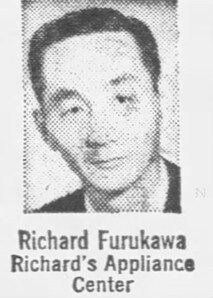
Photo right: Mid 1960s
Furukawa was very active in the Rural Chapter of the 442nd Veterans Club. The Rural Chapter was formed for veterans from Waialua and Wahiawa. He served as Vice President in 1952, Treasurer in 1958, and President in 1960. He was chosen by his comrades to represent the 442nd in the Hawaii Statehood Delegation to the U.S. Congress in Washington DC in May 1954, with veterans of other organizations.
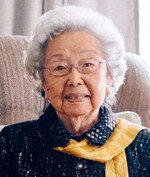
Left: Chizuko in the late 1990s
In 1995, Richard Furukawa gave his wartime memories to former Platoon Sergeant Genro Kashiwa for the L Company Memoirs. He noted:
We had to show the entire USA the fact that though of Japanese ancestry, we are America’s first…..Though unsaid, each of us knew and understood our mission. This produced a unique, compelling goal for the 442nd RCT. The fact that it was a segregated unit composed of Americans of Japanese ancestry with a mission, resulted in an outfit with an exceptional degree of camaraderie, which in turn produced a very effective combat unit.
Richard Furukawa died on November 10, 1996, at the age of 74, at Pali Momi Medical Center in Aiea, a suburb of Honolulu. He was inurned at the National Memorial Cemetery of the Pacific at Punchbowl, Court 13-S, Row 200, Site 214. On his niche is engraved 442nd Inf Regt WWII, Go For Broke, Forever in Our Hearts. Survivors included his wife Chiyoko, three daughters, step-mother Hanako, brother Hubert, sisters Adaline Young and Gertrude Kajiwara, six grandchildren, and one great-grandchild. His memorial service was held on November 24 at Mililani Mauka Chapel, followed by a graveside service at Punchbowl the next day. His widow Chizuko died on February 25, 2001, and was inurned with her husband.
Researched and written by the Sons & Daughters of the 442nd Regimental Combat Team in 2025.